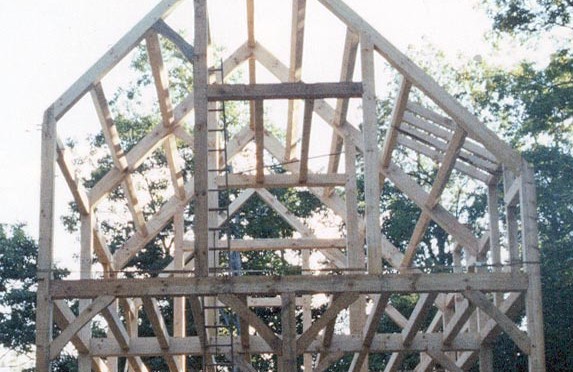“All the world’s a stage, and all the men and women merely players.” Shakespeare wrote that in As You like It. If that’s truly the case, then stories themselves are houses. Let me explain.
 Consider the framework for a simple A-frame house. It’s got four walls and a pitched roof. The structure of the story, any story, is like the framework of that A-frame house. It doesn’t change, no matter what. It is the support, regardless of the dressing. We’ll go into more detail about structure in a later post, but for now, we’ll just hit the highlights. This framework, in all fiction, will have five parts.
Consider the framework for a simple A-frame house. It’s got four walls and a pitched roof. The structure of the story, any story, is like the framework of that A-frame house. It doesn’t change, no matter what. It is the support, regardless of the dressing. We’ll go into more detail about structure in a later post, but for now, we’ll just hit the highlights. This framework, in all fiction, will have five parts.
The left side wall is the Exposition, or Introduction. This is the part of the story where characters are introduced and relevant background information is revealed. The inciting incident occurs in this section.
The left pitch of the roof is the Rising Action. This is the part of the story where conflict is revealed the story progresses. A series of challenges and setbacks occur in this section to add interest.
The pitch of the roof is the Climax. This is the turning point of the novel, where suspense has built and the reader is caught up in the action, or surprised by the turn of events. This is the part with the most on the line for the protagonist—the most is on the line here.
The right pitch of the roof is the Falling Action. These events are usually the after effects of the decisions made during the climax, and therefore occur immediately after the climax.
The right side wall is the Denouement or Resolution. This is the ultimate conclusion and resolves any unaddressed conflicts that progressed throughout the story. There should be a release of any tensions at this point, and all mysteries should be solved.
Most fiction today is written in a three act structure. You can think of it as the three floors of the home (ground floor, second floor, and attic).
The Ground Floor is the beginning, or the setup. It tells who the characters are and what happens to them, right up to the inciting incident, or the thing that happens that sets the story in motion.
The Second Floor is the middle of the story. It’s where most of the book takes place. It’s where all the challenges and obstacles occur that keep the protagonist away from the goal.
The Third Floor is the end of the story. It’s when the protagonist finally reaches the goal and everything gets wrapped up.
These floors correlate to the side walls and roof, don’t they? You bet. Shouldn’t the framework of a house work together? You bet.
Now, it really doesn’t matter how you dress this thing up. It can be a western with weathered wood siding. A southern Civil War historical with columns and a wrap-around porch. A legal thriller Bostonian brick brownstone with a stately pediment above the door. None of that matters. What matters is that you build three sturdy floors, with solid walls, and a perfectly pitched roof. The dressing is all up to you. Variety is the spice of life, or, in this case, my bookshelf.
Posted for WordPress DPchallenge Easy as Pie
photo credit: Patrick Dinnen licensed under Creative Commons.

11 Responses
Nice way to visualize the structure of a story. Thanks, Staci.
Thanks, Patricia. After you build as many houses as we have, it’s hard not to make the comparison.
Great blog Staci. I never thought about writing and construction of a house being similar. And all the different stages that we go through to develop a wonderful story. Like dominoes falling gracefully along a path until it reveals its final project. Cool and thanks for all you insight.
Thanks Rhonda.
I think I might be able to outline a story now!! You always have great advise Staci thank you for sharing! Question….Since the basement is the subplot would the guest house be a sequel? 🙂
Clever. If you do build a guest house, make sure to follow the same structure!
Great analogy. Would the basement as subplot work here? 🙂
I love chatting with clever authors… they can always take my analogies further than I’ve gone.
And I was worried people were going to talk about the skeletons in my closets!
Lol. 🙂
Hey Staci, Terrific analogy! I love it. I think even folks like me, who just start writing and see where we end up, have this basic structure (or certainly should!) in the back our minds. I love how you made me see the story structure as a basic frame from which to build a million stories.
Thanks Pam. It probably helps me to think that way because I took architecture classes in college. That, and Corey and I have built four houses since we’ve been married, plus another as an investment property. I think I’m obsessed!